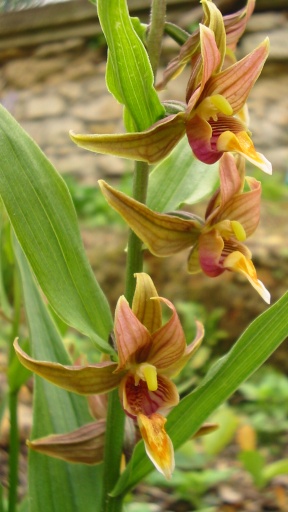Epipactis gigantea facts for kids
Quick facts for kids Epipactis gigantea |
|
|---|---|
 |
|
| Scientific classification | |
| Genus: |
Epipactis
|
| Species: |
gigantea
|
| Synonyms | |
|
|
Epipactis gigantea is a special type of orchid. People call it the stream orchid, giant helleborine, or chatterbox. This beautiful wildflower grows naturally in western North America. You can find it from British Columbia in Canada all the way down to central Mexico. It's one of the most common orchids along the Pacific coast of North America.
Contents
What the Stream Orchid Looks Like
The stream orchid, Epipactis gigantea, is a plant that stands upright. It can grow from about 30 centimeters (about one foot) to one meter (about three feet) tall. It is a perennial plant, which means it lives for more than two years.
Its stems have leaves that are shaped like a spear. These leaves are 5 to 15 centimeters long and have clear veins. Near the top of the plant, you'll find its flowers. These flowers grow in a cluster called an inflorescence. There are usually two or three showy orchids in each cluster.
Each flower has three straight parts called sepals. These sepals are light brownish or greenish. They have darker lines, like tiny veins, and are about one to two centimeters long. The two top petals of the flower are reddish-brown with purple veins. The lowest petal is shaped like a cup. It has a pointed, tongue-like part sticking out. This petal is usually a brighter red-brown and has very clear veins, often with yellow spots.
After the flower blooms, it produces a fruit. This fruit is a hanging capsule, about 2 or 3 centimeters long. Inside this capsule are thousands of tiny seeds.
Where the Stream Orchid Grows
This plant loves wet places. You can find it in many different natural areas. It often grows along riverbanks, near hot springs, and in meadows. It can be found at high elevations, from about 2,800 feet to 8,000 feet above sea level.
Unlike some other orchids, the stream orchid is an autotroph. This means it makes its own food using sunlight, just like most plants. It doesn't need to get nutrients from fungi in the soil.
There's a special type of this orchid with burgundy-colored leaves. It grows in a place called The Cedars in Sonoma County, California. This area has a unique type of rock called serpentine rock. This special plant is known as forma rubrifolia.
Growing Stream Orchids
People also grow Epipactis gigantea in gardens. It's sold by special plant growers as an ornamental plant. This means it's grown for its beauty, not for food. These plants are grown from seeds or cuttings, so they are not taken from the wild.
There's also a specific type of this plant that gardeners like to grow. It has maroon-colored leaves, just like the forma rubrifolia mentioned earlier. This special type is called 'Serpentine Night'.
Images for kids
See also
 In Spanish: Epipactis gigantea para niños
In Spanish: Epipactis gigantea para niños





